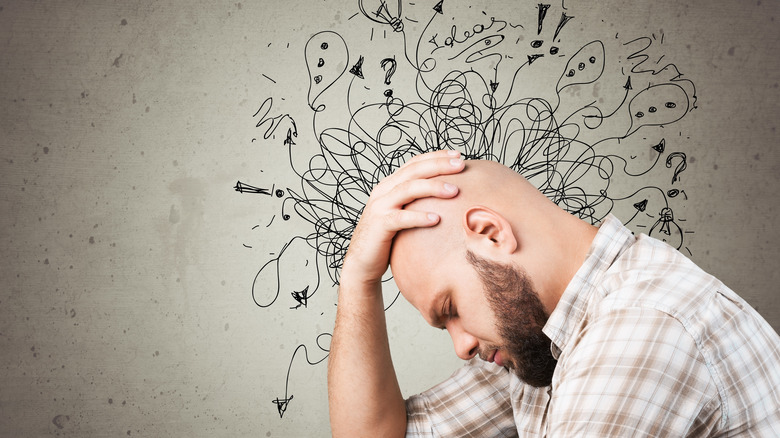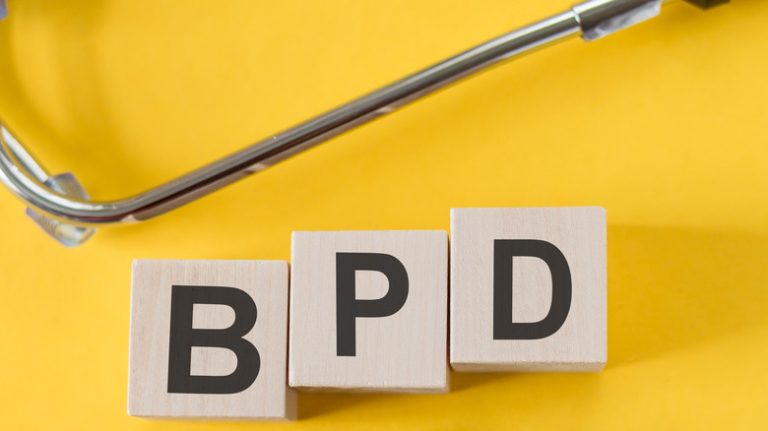Mental illness can be difficult to diagnose (via Annals of General Psychiatry). Unlike physical illnesses, such as diabetes and high blood pressure, there are no blood tests or medical instruments to pinpoint many psychiatric disorders. So, it’s important to consult a practitioner who has the right knowledge and expertise.
Depression, in particular, is commonly misdiagnosed, according to a study from Johns Hopkins Bloomberg School of Public Health. The researchers looked at 5,639 patients in an outpatient setting who were given a diagnosis of depression by a doctor or other medical professional. They discovered that only 38.4 percent of subjects actually met the criteria for major depression when re-assessed using a semi-structured interview. Many of these people were already using psychiatric medications for their symptoms.
A common reason for a misdiagnosis is that many disorders share overlapping features (per Annals of General Psychiatry). This can make it hard for primary care physicians to tease them apart clinically. But an erroneous diagnosis can cause various problems, a major one being that people might be prescribed inappropriate medications. It also means that an individual misses out on timely and effective treatment, which can cause their symptoms to persist or worsen. Read on to find out which conditions often mimic depression.
The main characteristics of depression

Depression, also referred to as major depressive disorder or clinical depression, can manifest differently across patients, per the National Institute of Mental Health (NIH). Like most mood disorders, the condition exists on a spectrum of severity: Its symptoms can range from fatigue to sadness to suicidal thoughts and behavior. The spectrum is more diverse than what’s reflected by the current diagnostic guidelines, according to some researchers (via Frontiers in Psychiatry).
Based on the current edition of the Diagnostic and Statistical Manual of Mental Disorders (DSM-5), the core features of depression are low mood, feelings of hopelessness, and a loss of motivation or interest in things, per the National Institute for Health and Care Excellence (NICE). To meet the criteria for a diagnosis, these symptoms must show up, most days, for at least two weeks. For some people, these symptoms may interfere with their ability to function and get stuff done, whereas others are still be able to go about their usual day-to-day activities. Other common symptoms include a loss or increase in appetite, the inability to fall asleep, difficulty making decisions, and unexplained guilt.
There are other forms of depression too, like seasonal affective disorder (SAD), which typically takes root in the winter (via NIH). Persistent subthreshold depressive symptoms, sometimes called dysthymia, is a milder, longer lasting type of depression. And then there’s perinatal or postpartum depression, which affects women during pregnancy or after giving birth.
Bipolar disorder

Bipolar disorder is a complex and mysterious illness that’s often misdiagnosed, according to research (via the Journal of the American Association of Nurse Practitioners). Around 60% of people with bipolar disorder are initially told that they have depression, and only 20% of patients are given the correct diagnosis in the first year of treatment. This means that some people are oblivious that they even have this serious, sometimes debilitating disorder.
Bipolar disorder and depression can look very similar at first glance, according to the Journal of the American Association of Nurse Practitioners. People with either condition tend to grapple with a depressive mood. This can be energy-sapping at times, and may impair various aspects of their lives. A major difference, however, is that bipolar disorder is marked by a combination of manic, hypomanic, and depressive episodes, whereas people with depression might not experience mania at all.
There are a number of reasons why bipolar disorder can be overlooked. It’s easy to miss if the patient isn’t exhibiting any severe symptoms, such as mania or rapid cycling, where they swing from a high to low mood. Research shows that people can live with the illness for years before receiving a diagnosis (per Acta Psychiatrica Scandinavica).
However, some of the antidepressants that are used to treat depression can exacerbate the symptoms of bipolar disorder (via the Journal of the American Association of Nurse Practitioners). This can lead to harmful outcomes, including antidepressant-induced mania and suicidality.
Chronic fatigue syndrome (CFS)

It’s estimated that more than 80% of people with chronic fatigue syndrome (CFS) don’t have a proper diagnosis (via Medical News). CFS can be a pretty demoralizing condition when an individual is in the dark about what they’re struggling with.
Many people are erroneously informed that they have depression, according to research (via Journal of Clinical Psychiatry). The two disorders share many characteristics, the main one being prolonged and debilitating fatigue. People with either condition also experience sleep problems, digestive issues, physical pain, and attention and memory problems (via WebMD). There are some symptoms of CFS that don’t fall under the diagnosis of depression, however, such as a recurring sore throat, tender lymph nodes, and joint pain.
Many people with CFS develop comorbid depression due to the various challenges they’re faced with (via Journal of Clinical Psychiatry). It’s important for clinicians to detect and treat these illnesses separately to help prevent their symptoms from worsening. One of the main difficulties with diagnosing CFS is that there aren’t any specific tests or markers for pinpointing it. The treatment pathway for CFS also remains somewhat poorly defined. As a result, many primary care practitioners and psychiatrists are reluctant to diagnose the condition.
Attention deficit hyperactivity disorder (ADHD)

Billion Photos/Shutterstock
Attention deficit hyperactivity disorder (ADHD) is a commonly misdiagnosed mental illness (via Primary Psychiatry). It’s often misidentified as depression, since ADHD symptoms can look a lot like depressive symptoms, Roberto Olivardia, a clinical associate and lecturer in psychology at Harvard Medical School, told CHADD. A key way to differentiate between the two disorders is to consider whether the loss of interest that a patient experiences is persistent or fleeting. For example, patients with ADHD may feel down when they’re under-stimulated, but this tends to lift when they do something they enjoy. This is usually an indicator that they don’t have clinical depression.
It’s estimated that 18.6% of people have both ADHD and depression (via CHADD). When people feel overwhelmed by their inability to focus, remember things, and complete important tasks, they may spiral into an emotional rut (per ADDitude). Many people self-diagnose their difficulties as anxiety or depression.
A large number of people live with ADHD for years without receiving a diagnosis (via Primary Psychiatry). Many primary care physicians feel uncomfortable diagnosing ADHD due to a lack of thorough and straightforward screening tools. Around 44% of clinicians feel that there isn’t a “clear diagnostic criteria.”
If left untreated, the symptoms of ADHD can worsen (via ADDitude). A lack of a diagnosis or a misdiagnosis can result in people being given the wrong information or medications. With the right kind of support, however, people with ADHD can lead healthy, productive, and fulfilling lives.
Post-traumatic stress disorder (PTSD)

SeventyFour/Shutterstock
Post-traumatic stress disorder (PTSD) is widely underdiagnosed, according to the BMJ. It’s often mistaken for more common disorders like depression. This is concerning, because adults with PTSD are six times more likely than others to attempt self-harm or suicide, and a lack of adequate support may amplify this risk even more.
PTSD and depression have many symptoms in common (via Dialogues in Clinical Neuroscience). Irritability, anhedonia, sleep disturbances, and concentration difficulties are just some of the main symptoms that can crop up for people with either disorder.
The two conditions tend to co-occur: As many as 50% of people with PTSD also suffer from depression, which can make it difficult for general practitioners to confuse one disorder with the other (via Dialogues in Clinical Neuroscience).
Although PTSD and depression are similar in a lot of ways, they’re ultimately distinct conditions (via Dialogues in Clinical Neuroscience). A key difference that clinicians should look out for is the experience of a traumatic event that triggered the PTSD symptoms, say researchers. Patients may suffer from flashbacks, recurrent nightmares, and hyperarousal, which don’t necessarily show up in people with depression.
Endometriosis

Dragana Gordic/Shutterstock
Endometriosis is a painful gynecological condition that affects up to 10% of women of reproductive age in the United States, per Johns Hopkins Medicine. The illness occurs when tissue that lines the uterus grows outside of it, such as in the ovaries or fallopian tubes.
Chronic pain associated with endometriosis can take a pretty heavy toll on a woman’s mental health, note researchers (via International Journal of Environmental Research and Public Health). One of the most common symptoms of the condition is pelvic pain, which can lead to a reduced quality of life. It’s not surprising then that healthcare professionals sometimes fail to identify endometriosis, and may attribute its symptoms to depression instead, per Refinery29.
A 2024 meta-analysis of studies found that depression is more prevalent among women with endometriosis than those without it (via American Journal of Obstetrics and Gynecology). Pain is often the number one cause of a plummeting mood. One study showed that women were just as likely to be depressed when they had pelvic pain without endometriosis as women who had both endometriosis and pelvic pain. For this reason, it can be helpful for clinicians to pin down and treat the root cause of these symptoms early.
Fibromyalgia

fizkes/Shutterstock
Fibromyalgia is a chronic pain condition that’s still shrouded in mystery, according to the Anxiety & Depression Association of America (ADAA). It affects somewhere between three to 6 million adults in the United States, and around 20% of people with the disorder also suffer from depression.
Many of the characteristics of fibromyalgia — tiredness, sleep woes, changes in appetite, and problems with thinking — can mimic the symptoms of depression (per Psychology Today). The two conditions have a lot in common. Unsurprisingly, fibromyalgia sufferers are three times more likely to be wrongly diagnosed with depression when seeking help for the first time. One of the key features of fibromyalgia, which may not affect those with depression, is widespread pain and tenderness throughout the body.
Fibromyalgia and depression have a bidirectional relationship (via Cureus). Research shows that people with depression have a greater chance of developing fibromyalgia at some point during their lives. On the other hand, the discomfort and frustration caused by fibromyalgia can play havoc with a person’s mood, causing depressive symptoms over time.
The sparse research around fibromyalgia and the uncertainty about its existence are key factors contributing toward its frequent misdiagnosis (via Cureus). The validity of a fibromyalgia diagnosis has been called into question, which can mean that some clinicians are hesitant to identify the illness and tend to point toward depression instead.
Anemia

KaryB/Shutterstock
Anemia is a blood disorder that’s often caused by lack of iron (via StatPearls). People with the condition have low levels of red blood cells. As a result, their organs and tissues don’t get enough oxygen. Some of the symptoms that people develop over time include tiredness, weakness, lethargy, and restless legs syndrome. Doctors sometimes blame these on a mental health issue such as depression, anxiety, or even burnout (per BMC Womens Health).
The misdiagnosis of iron deficiency anemia might seem unusual given its high frequency in non-pregnant women (via BMC Womens Health). This can have a number of dire consequences for moms-to-be, including unsuccessful treatment outcomes, poor disease management, delayed recovery, and a harsh impact on individuals’ quality of life. People with anemia may develop a sense of helplessness the longer their condition remains invisible, which can lead to depression in the long-term.
An iron deficiency can also give rise to low mood and rob people of their energy and motivation (via Psychiatry and Clinical Neurosciences). Shortness of breath, chest pain, and unusual cravings are a few symptoms that may help differentiate between anemia and depression (via StatPearls). Your doctor can also use a blood test to check your complete blood count (CDC) before diagnosing you with anemia.
Hypothyroidism

Photoroyalty/Shutterstock
“More than 12% of Americans will develop a thyroid condition in their lifetime” per Healthline. Around 60% of these individuals are living without a clear diagnosis. Instead, many patients are told that they may have a mental health problem like depression.
Hypothyroidism is a form of thyroid disease in which the thyroid gland doesn’t produce enough thyroid hormones (via the Journal of Thyroid Research). Clinically, hypothyroid patients often report depressive symptoms: low mood, irritability, tiredness, and brain fog. Depression occurs in up to 31 to 69% of patients. But in more severe cases, a thyroid hormone deficiency could present as dementia or psychosis, point out researchers (per The Journal of Clinical Psychiatry).
One of the biggest concerns around an inaccurate diagnosis is that the hypothyroid patient misses out on early treatment (via Healthline). Sometimes this can make thyroid dysfunction worse, according to The Journal of Clinical Psychiatry. An underactive gland should be treated with thyroid hormone replacement. A delay in effective treatment can aggravate both physical and emotional symptoms. Luckily, a blood test can help straighten things out. Clinicians can check levels of thyroid-stimulating hormone (TSH), thyroxine (T4), and triiodothyronine (T3) in the blood to prevent the painful mishap of a misdiagnosis.
Diabetes

Poultry Graphics/Shutterstock
It’s common for people with type 2 diabetes to have depression-like symptoms, per Diabetes UK. Often, they feel low, irritable, and tired. They may find themselves sleeping a lot or struggling to drift off, and sometimes having difficulty concentrating. In both type 1 and type 2 diabetes, people can feel overwhelmed about managing their condition, also termed “diabetes distress,” which may be misdiagnosed as depression (via Endocrinology, Diabetes & Metabolism).
The relationship between diabetes and depression is complex (per The Journal of Medicine and Life). People with depression have a 60% greater likelihood of developing type 2 diabetes, while diabetes acts as a major risk factor for developing depression.
High blood sugar can lead to a low mood by bringing about various physiological and neurological changes in the body (via Geriatric Medicine Journal). By the same token, symptoms of depression, such as weight gain, off-kilter circadian rhythms, and feelings of helplessness, have been shown to make diabetes worse.
It’s important for doctors to distinguish between these conditions early in order to minimize the vicious cycle between them, notes Diabetes UK. Depression can make it hard for people to manage their diabetes, such as taking their medication, testing their blood sugar levels, and exercising and eating in a helpful way. They may even avoid taking the necessary steps to seek treatment.
Alcohol or substance withdrawal

AlexandrMusuc/Shutterstock
Drug withdrawal and depressive symptoms can often go hand in hand, per the American Addiction Centers. The physical and psychological aspects of the withdrawal process can negatively affect an individual’s mental well-being, especially within the first week. Other common symptoms include agitation, fatigue, and insomnia. So, if you’re not aware that a person is undergoing withdrawal, you could easily assume that they’re down in the dumps.
A low mood is commonly observed in people who are withdrawing from various types of substances, including nicotine, stimulants, opioids, and even antidepressants (via Brain Communications). These drugs act on your body’s central nervous system, causing its functions to speed up or slow down. When you suddenly stop using them after developing a dependance, your central nervous system quickly tries to adapt and restore balance. This may contribute to depressive symptoms and episodes.
The symptoms of alcohol withdrawal can also mimic depressive symptoms, per American Addiction Centers. This is because alcohol binds to your brain’s gamma-aminobutyric acid (GABA) receptors, decreasing glutamate levels and increasing GABA in your central nervous system, according to the Journal of Clinical and Diagnostic Research. So, when you quit drinking, your brain tries to reset itself, which can lead to a chemical imbalance in the brain.
Vitamin D deficiency

vectorfusionart/Shutterstock
Low mood, being tired, and general aches are just some of the features of low vitamin D (via Patient). A vitamin D deficiency occurs when your body doesn’t get enough vitamin D from the sun or food. People may not have any symptoms right away, and its effects can sometimes be subtle.
In some people, low levels of vitamin D can mirror a mood disorder (per Mayo Clinic Proceedings). People may also become more susceptible to muscle pain and weakness. And so, it’s no surprise that those with a vitamin D deficiency are sometimes mistakenly identified as struggling with depression.
Research shows that many patients diagnosed with depression have plummeting levels of vitamin D in their blood (via Current Drug Targets). There’s also evidence that insufficient vitamin D elevates an individual’s risk of depression, according to Scientific Reports. Therefore, clinicians should test at-risk people for low levels of vitamin D, say researchers (per Mayo Clinic Proceedings). This could help them treat a potential nutrient deficiency before it leads to other physical or mental health issues.




